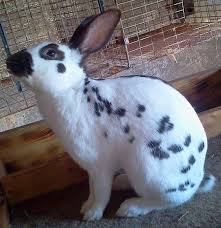- COUNTRY OF ORIGIN: England
- YEAR RECOGNIZED: 1914
- USES: Show, fur, meat
- WEIGHT: 8 pounds (3.6 kg) max., senior does
- BODY TYPE: Full-arch
- FUR TYPE: Flyback; ARBA Commercial Normal Fur Standard; short, dense, fine, lustrous
- COLORS: Black, blue, chocolate, gold, gray, lilac, or tortoiseshell markings on a white body
SPOTTED RABBITS WERE KNOWN IN ENGLAND for more than 200 years before careful selective breeding began. By the late 19th century, however, they had became regular winners at rabbit shows and achieved quick success when they were exported to Germany in 1889. The increasingly refined English Spot breed was imported by American breeders in the early 1900s and accepted by a forerunner of the ARBA as a distinct breed in 1914.
The English Spot is not the easiest rabbit to identify, although it is usually somewhat smaller than the similarly marked Rhinelander and considerably smaller than the Checkered Giant, another spotted breed. The Spot, at least superficially, resembles both breeds in conformation as well as color. Diagnostic, however, are the dark markings on the shoulders of English Spots. Like the Giant and the 10-pound (4.5 kg) Rhinelander, neither of which has shoulder spots, the 8-pound (3.6 kg) English Spot has a full-arch profile with the long, lean body of a hare.
By some accounts, the Spot is harder to handle and less adaptable to other pets than most rabbit breeds. It is also a difficult rabbit to breed to standard because its value in the show ring is attached largely to the arrangement of its spots.

